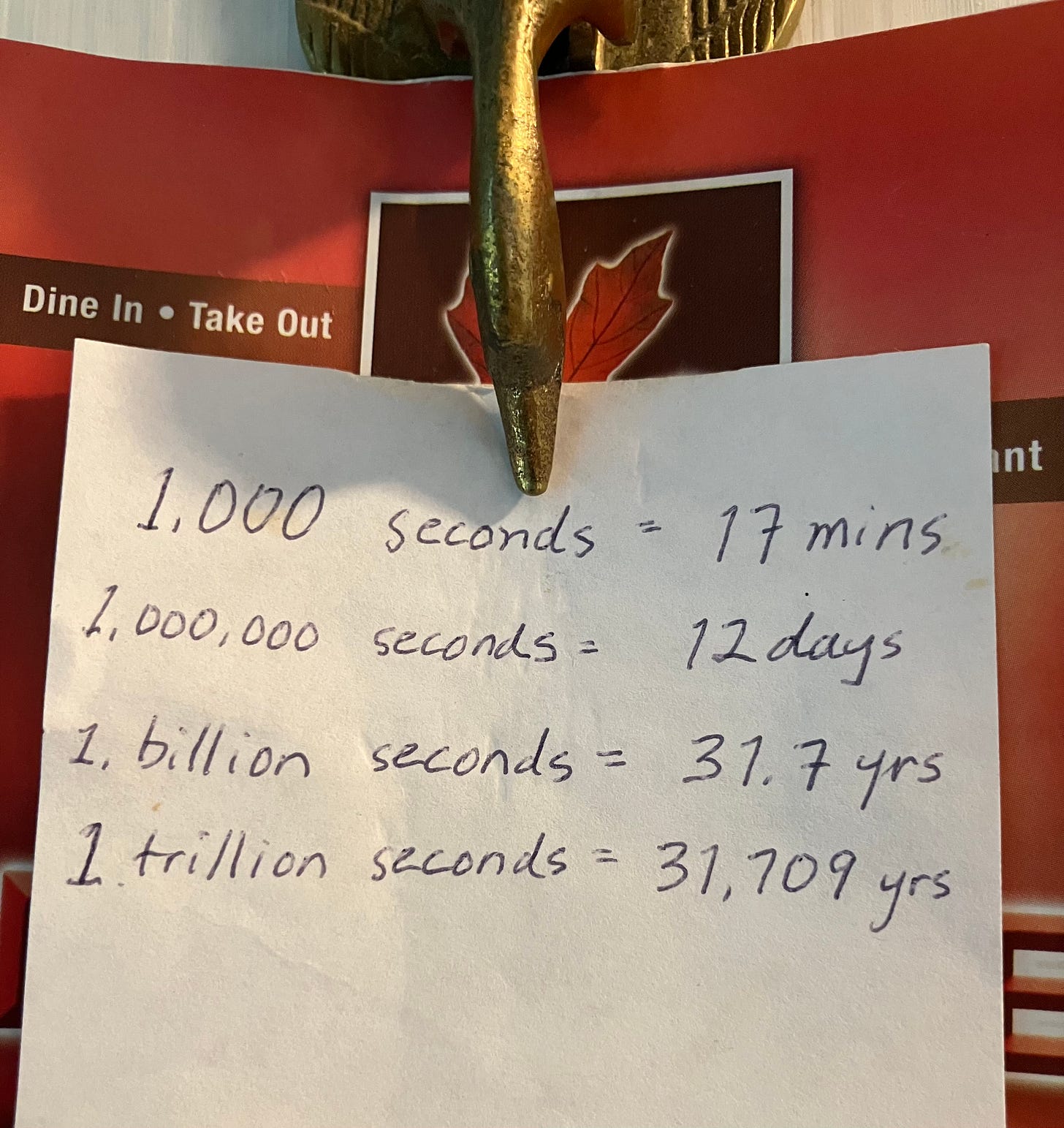The weight of a trillion seconds
how zeros stretch time, debt and imagination
My daughter Molly turns 31.7 years old today, September 25, 2025. She will have been living for one billion seconds around 2:42am (EDT) this morning. It’s a huge milestone.
Some time ago, a teacher in a classroom presented the following thought experiment. She stood at the wall in the back of the class and said “Imagine that the wall at the front of the class represents zero, and this back wall represents 100. How far from the front wall is the value 10?”
This was easy. It’s a tenth the distance from the front wall to the back wall. The room was about 30 feet from front to back, so three feet from the front wall is where 10 would be. Another 3 feet would be 20. And so on until you get to 100 - the back wall.
“If the back wall is 1,000, where is 100?” she asked. Also easy. Same rule applies. One tenth of the way from the front wall, or three feet.
Then she asked, “If the back wall is 1,000,000 where is 1,000 ? This tripped up some people. One person suggested it would be one-tenth of the way back, which is obviously way off. Another guessed one-hundredth of the way to the back. Also wrong.
The correct answer is 1/1,000th of the distance. One million is equal to one thousand units of 1,000. One thousandth of 30 feet is .36 inches. A little more than a third of an inch. About the thickness of the white board mounted on the front of the classroom wall.
The same rule applies to other proportionate values: if the back wall is a billion, a million is one third of an inch from the front. If the back wall is a trillion, a billion is one-thousandth of the distance front to back — 1/3rd of an inch, plus a bit.
Adding three zeros makes an enormous difference.
OK, so here’s the next question: If my daughter was born a billion seconds ago (31.7 years), how long ago is a trillion seconds? It’s more than I thought.
It’s 31,688 years ago. That lands us at about 29,633 BCE. Our ancestors were modern humans back then, just after the last Ice Age. They were hunter-gatherers, used stone tools, and probably had domesticated dogs by that point. But it would be another 20,000 years before homo sapiens had cities, agriculture or writing.
Think of the span of time our brains lived at a slower pace, with a shorter life, with most of our daily tasks related to survival of the family and of the species — shelter, food, warmth, clothing, keeping children alive and healthy. And how little time we have had to adapt to clocks, engines, industrial waste and smartphones.
The concept of a trillion comes up here and there. We use terabytes (TB) as a measure of storage capacity. That’s one trillion bytes, give or take. The national debt is in the trillions. I looked up the official numbers on the web, from the Joint Economic Committee of the Senate. (You should check it out before the administration takes it down claiming it contains “divisive” information that makes us feel bad about our country.) Here’s what I found:
WASHINGTON, DC – Today, the Joint Economic Committee released its monthly debt update. As of September 4 [2025], total gross national debt is $37.43 trillion. Relative to one year ago, total gross national debt is $2.09 trillion higher; compared to five years ago, it is $10.73 trillion higher.
Over the past year, the rate of increase averaged $5.72 billion per day, $238.16 million per hour, $3.97 million per minute, or $66,156.25 per second. This increase over the past year amounts to $6,132.36 per person or $15,779.51 per household. In all, total gross national debt amounts to $110,020 per person or $283,098 per household.
If the average daily rate of growth continues at the same pace as the past three years, the U.S. will reach $38 trillion by approximately December 09, 2025. At that rate, an increase of another trillion dollars would be reached in approximately 169 days [from then].
So, by December of this year, our national debt will be equivalent to $38 dollars for every second of time since our ancestors drew pictures of animals on the cave walls in France.
I remember watching a movie in the eighth grade. The idea was to imagine the timeline of the earth’s history as one calendar year. Here are some highlights:
The earth forms January 1.
Bacteria evolve March 4.
The summer’s main event: bacteria pump oxygen into the atmosphere.
The first multicellular life appears October 25, well into autumn.
Dinosaurs appear December 17 and are extinct 9 days later.
The rise of mammals happens December 27.
First anatomically modern humans appear December 31, 11:52 PM.
Agriculture begins 11:59 and 46 seconds.
Industrial revolution begins 11:59:58, two seconds before the present.
I have a few summary points from all this:
It is amazing to see what a creative, thoughtful and cultivated life can happen within a billion seconds.
Powers of ten scale up more quickly than we might imagine.
Our national debt increases by an amount equivalent to the monthly SNAP benefits (US government food assistance program) for 350 people ($66,000) each second.
The lucky among us have a good 3 billion seconds on Earth before we move on.
Earth’s history is mostly not about us.
Machines and equipment dominated the globe a couple seconds ago.
I am left with feeling a combination of humbled, alarmed and amazed – one third of each, in equal measure – and this question:
How will we shape the world in the next two seconds?
Notes
Excerpt from Senate Joint Economic Committee report Sept 4, 2025
What do we mean by the “national debt”? It’s not like personal credit card debt. I found this short piece from the Pew Research Center very helpful: “Key Facts about the US National Debt.”
Information about the Supplemental Nutritional Assistance Program (SNAP) run by USDA







This is SO good, Stewart. Math is hard. Hats off to you for educating me in such an engaging way and driving your point home. I think a little humility is call for from all of us. In the scope of things, we really are toddlers or maybe even newborns. xo
Wow, Mr. M.E. As Nan suggests, math feels hard to this "me." It's not just from leaning into cultural messaging. I truly feel there's a learning difference going on. I've managed myself around it all these years, but for a minute I was afraid I was going to have to admit to not understanding this. Yet you walk the reader through with such clear language and illustrations that the connections go where they need to go. Well done!
And ouch. The sudden negative impacts of our human "progress" on the planet is always a sobering concept, one I think most of us can't fathom. And the dollars. THE DOLLARS!!
Thanks for this timely piece. Sharing.